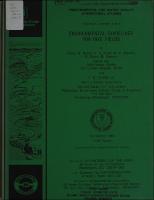Please use this identifier to cite or link to this item:
https://hdl.handle.net/11681/4548| Title: | Environmental guidelines for dike fields |
| Authors: | Versar, Inc. Burch, Carey W. Abell, Phillip R. Stevens, Michael A. Dolan, Robert Dawson, Brenda L. Shields, F. Douglas |
| Keywords: | Aquatic biology Aquatic ecology Dikes Hydraulic structures Design Construction Environmental aspects Environmental effects Environmental management Fish Fishes Habitat improvement Rivers Waterways |
| Publisher: | Environmental Laboratory (U.S.) Engineer Research and Development Center (U.S.) |
| Description: | Technical Report Abstract: The environmental guidelines for dike fields contained within this report consist of environmental objectives, design procedures, and river-specific examples of currently employed environmental features that can be used to maintain or increase fish and wildlife habitat diversity . Design, construction, and maintenance of dikes can alter the water depth, current velocity, and substrate composition to increase habitat diversity of US Army Corps of Engineers waterway projects. Features discussed herein that can be incorporated into dike fields to increase diversity are notches, low-elevation dikes, rootless dikes, and minimum maintenance practices. Other potential techniques include dredging to remove sediment, disposing of dredged material within the dike field, relocating old notches, placing additional rock, adding artificial reefs, and building control structures in side channel closure dikes. Two case studies--one on the Missouri River, one on the lower Mississippi River--of river response to dike field construction are presented. Aquatic habitat requirements of representative vertebrate species and of aquatic invertebrates in general, as well as a subject reference index, are given in appendixes. NOTE: This file is large. Allow your browser several minutes to download the file. |
| Rights: | Approved for public release; distribution is unlimited. |
| URI: | http://hdl.handle.net/11681/4548 |
| Appears in Collections: | Technical Report |
Files in This Item:
| File | Description | Size | Format | |
|---|---|---|---|---|
| TR-E-84-4.pdf | 41.31 MB | Adobe PDF |  View/Open |